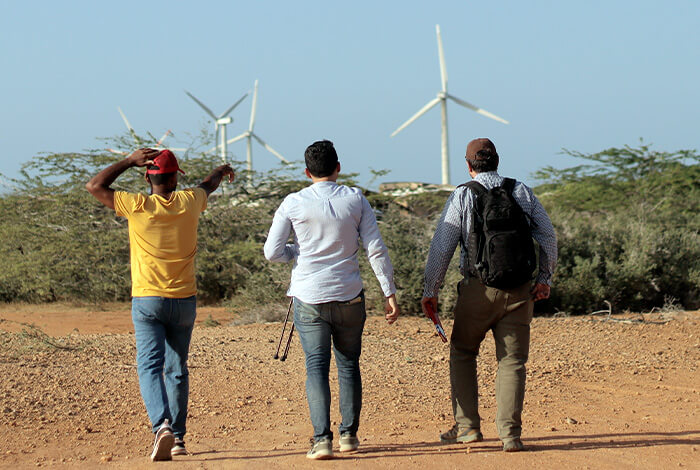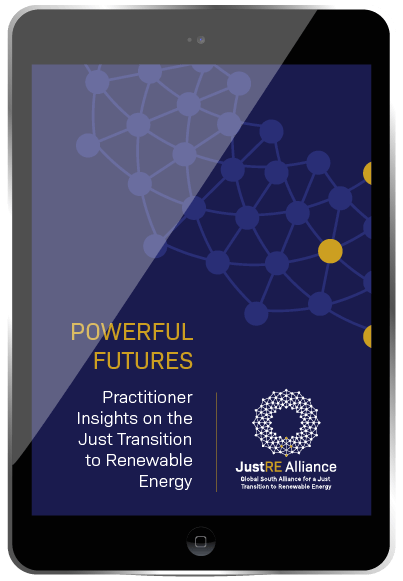Utility-scale renewable energy projects can trigger multiple interactions between developers and communities who inhabit, use, or transit the land they occupy. This chapter discusses the challenges of these interactions and how community engagement can be done effectively.
Context
A complex interplay between stakeholders affected by RE projects is almost inevitable. Given the long-term nature and scale of these projects, the rights and interests of the community should be safeguarded. When done responsibly, renewable energy projects can benefit communities, particularly those most vulnerable, such as Indigenous Peoples. The question is how the project can generate local development, uphold human rights and protect the environment. Answering this necessitates effective community engagement, which includes close conversations and trust-building processes amongst all stakeholders.
Utility-scale renewable energy projects can be located in rural land or seascapes where livelihoods are under stress from climate change.[1]Christopher Atkinson and Allison Atkinson, 2023, Impacts of Climate Change on Rural Communities: Vulnerability and Adaptation in the Global South[2]Santos da Silva et. al., 2021, Power sector investment implications of climate impacts on renewable resources in Latin America and the Caribbean Often, host communities have experienced trauma from past exclusion, which can be exacerbated through poor engagement efforts and result in heightened distrust and risk of conflict. Social performance is defined as “the direct and positive social impacts on the wellbeing of individuals and communities during the development and implementation of energy projects that effectively and comprehensively improve the lives of people and local communities”.[3] Institute for Advanced Sustainability Studies, 2021, The Social Performance Approach: Fostering community well-being through energy-sector investments Underestimating community-related risks can generally result in insufficient investment in social performance, particularly in community engagement processes. Consequently, minimal or counterproductive community engagement may foster internal community divisions, generate resentment against the project, and, ultimately, impact the project’s social acceptance. Project delays and cancellations due to community opposition are costly and nonetheless generally poorly integrated into company risk assessments.
Despite the extensive guidelines available and the legal and/or institutional requirements for community engagement, project time and cost pressures usually result in hurried, superficial, compliance-based practices. Carrying out meaningful community engagement processes under project constraints is a challenge that many large development projects in energy and other sectors share.
Community engagement in practice is guided by norms and regulatory requirements which vary widely in different jurisdictions and for various groups. While stringent practices derived from Free, Prior and Informed Consent (FPIC)[4]Institute for Human Rights and Business, 2022, What is Free, Prior and Informed Consent (FPIC)? apply to Indigenous Peoples in many contexts, community engagement can become a merely transactional requirement guided by intermediaries who may not be aligned with communities’ interests, rather than an ongoing dialogue process to ensure long-term sustainability.[5]Stockholm Environment Institute, 2024, Enabling factors of social acceptance of wind energy projects in La Guajira Furthermore, in many cases, RE projects are exempt from community consultation requirements, such as public hearings, because they are considered inherently green, and therefore, good.
On the other hand, funding institutions, such as the International Finance Corporation (IFC), outline detailed social and environmental safeguards, including provisions for community participation in the projects they finance. The IFC’s Performance Standards on Environmental and Social Sustainability provide detailed guidelines for engagement and participation processes.[6]International Finance Corporation, 2012, IFC’s Performance Standards on Environmental and Social Sustainability To comply with these standards, developers must periodically report on their implementation to their lenders. Similarly, some private companies have detailed and context-specific community engagement strategies. However, little recourse exists for communities where standards are implemented superficially.
Emerging Good Practice
Community engagement is a common concept in project development, but is conceived and implemented in widely divergent ways and is highly dependent on the context. Adequate attention and resources are necessary to ensure that engagement strategies are high quality and result in the desired outcomes. Ensuring the participation of all relevant stakeholders, including vulnerable groups, and creating adequate space for them to contribute to decision-making are crucial. Meaningful community engagement is not merely a procedural requirement but a fundamental strategy for fostering a just energy transition.
Engagement should allow for a comprehensive understanding of stakeholder interests and priorities, including the potential synergies for shared prosperity and trade-offs. It is the basis for consensus building and the community’s acceptance of the project.
To establish meaningful community engagement, each party must understand what success and coexistence means for the other. While there will always be trade-offs, engagement aims to build joint value through synergies and distribute the costs associated with negative impacts that cannot be avoided or mitigated. Stakeholders often accept a project if they perceive the process has been conducted fairly through their participation and representation. Considering the above, a non-exhaustive chart defining the key stages of a basic model for meaningful community engagement is shown below.
Finding a common understanding is the ultimate goal of a community engagement process, and this requires consultations with all relevant groups, particularly vulnerable groups, such as Indigenous Peoples, who are often most at risk of adverse project impacts and have the least ability to claim their rights. In this sense, diversity and inclusivity are crucial in the engagement process. Diversity of knowledge and contexts is relevant, particularly in situations with significant power asymmetries between stakeholders.
Relevant Stakeholder Insights
Future glimpse
“Yesterday was an incredible day”, Thandiwe wrote in her journal. The journal has grown into many books in the two decades since her early twenties. She started it when she spent six months, in 2026, in the Initiative for Social Performance in Renewable Energy’s (INSPIRE’s) social performance programme for rising leaders in the renewable energy sector. The early entries reflect some difficult days. Conflicts with her social performance department manager or stories about sexual abuse or violence in the communities where she worked left her depleted. She wanted to hide and not leave her bed, let alone return to work the next day.
However, the training and a degree in social development with psychology as a major were the best preparation for her role as the bridge between the RE company and the communities where they work. Her last two decades have been based on a fundamental understanding of herself, her wounds, her triggers, and how to take care of and sustain her energy. She even mentors young professionals on this trauma-informed approach.
She suddenly flashed back to the day she knew she needed the INSPIRE training. She was meant to attend a community forum meeting with a project construction manager, who looked frightfully similar to an apartheid politician. By chance, he couldn’t attend that day, and the conversation with the community flowed much better than in previous engagements. In the end, she asked for feedback about the meeting, and a quiet old woman stood up and said: “we finally felt that we could speak freely. The manager you usually have with you reminds us so much of past injustices. Our hearts freeze when we see him, and it’s hard to want to join hands. Without him in the room, we feel better. Please leave him at the office in future, and we can hear you better”.
The community’s trauma from the past was triggered by the sight of this man, who unfortunately looked so similar to the former politician that they could not concentrate on the opportunities Thandiwe was discussing.
Today’s entry is so different. Yesterday, she witnessed the quiet old woman’s son become a member of the RE company board.
- Clean Energy Council, 2018, COMMUNITY ENGAGEMENT GUIDELINES For the Australian Wind Industry
- USAID, 2018, GUIDE TO COMMUNITY ENGAGEMENT FOR POWER PROJECTS IN KENYA
- BRE National Solar Centre, 2015, Community Engagement Good Practice Guidance for Solar Farms
- Taryn Lane and Jarra Hicks, 2014, Best practice community engagement in wind development
- Stockholm Environment Institute, 2024, Enabling factors of social acceptance of wind energy projects in La Guajira
- Initiative for Social Performance in Renewable Energy, 2020, Committing to community engagement
- Iniciativa Climática de México, 2020, Lineamientos para el Desarrollo de Proyectos de Energía Renovable Participativos, Incluyentes y Transpatrentes
- [1] Christopher Atkinson and Allison Atkinson, 2023, Impacts of Climate Change on Rural Communities: Vulnerability and Adaptation in the Global South
- [2] Santos da Silva et. al., 2021, Power sector investment implications of climate impacts on renewable resources in Latin America and the Caribbean
- [3] Institute for Advanced Sustainability Studies, 2021, The Social Performance Approach: Fostering community well-being through energy-sector investments
- [4] Institute for Human Rights and Business, 2022, What is Free, Prior and Informed Consent (FPIC)?
- [5] Stockholm Environment Institute, 2024, Enabling factors of social acceptance of wind energy projects in La Guajira
- [6] International Finance Corporation, 2012, IFC’s Performance Standards on Environmental and Social Sustainability
- [7] Initiative for Social Performance in Renewable Energy, 2024, Trauma-informed leadership in Community Development: A case study of the Xazulula project in South Africa
- [8] Food and Agriculture Organization, Voluntary Guidelines for Securing Sustainable Small-Scale Fisheries in the Context of Food Security and Poverty Eradication [Accessed in June 2024]
- [9] National Geographic Society and African People & Wildlife, 2019, Community, conservation, and collaboration: A framework for success. National Geographic Society
- [10] Corte Constitucional República de Colombia, Sentencia T-969/14
- [11] Ministerio de Cultura. Perú, 2013, Consulta a los Pueblos Indígenas. Guía Metodológica




